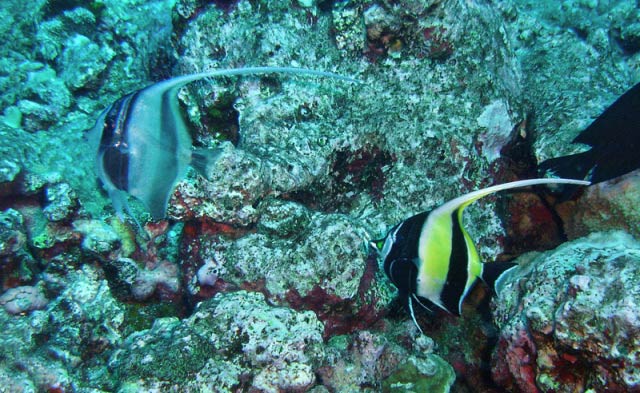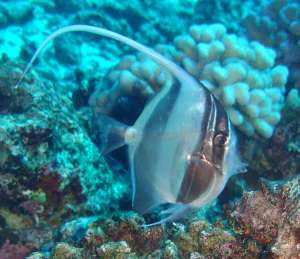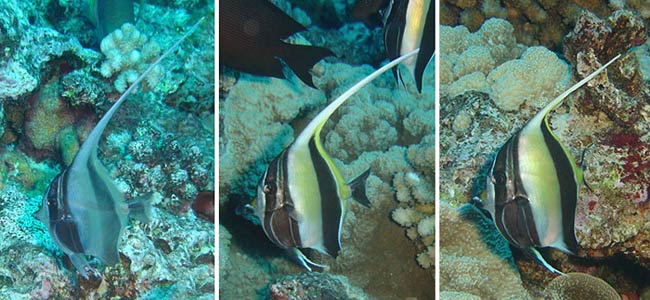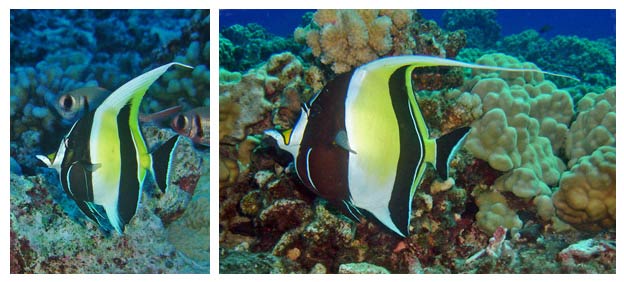How long does it take to become opaque?
As Hawaii’s divers and fish-watchers are well aware, this summer will go on record as the largest settlement of juvenile fishes (recruits) recorded in historic times. Estimated millions of Blacklip Butterflyfish, thousands of Yellow Tangs, and hundreds or thousands of individuals of numerous other species settled out of the plankton on reefs on Oahu, Maui, Molokini, the Big Island and most likely other islands as well.
The settlements are not over yet, however. As of mid-September, recruits of some species are still settling. As our dive guide Warren Blum puts it, “We’re receiving new products all the time.” One of these “new products” is the Moorish Idol.
As divers, it is incredibly rare for us to see a reef fish in the first few days after it has settled on the reef. Most species, when they arrive, are transparent and/or silver, and hide down in the reef, some emerging only at night. During this time they undergo what is called transformation, where they become opaque, add color, and can change dramatically in body shape and fin length. Normally, by the time we notice new recruits, they have their color and look like juvenile fish.
Because Moorish Idols are comparatively large when they settle out of the plankton (about 3 inches), and because they are more likely to be out during the day before they have fully transformed, we get to see them while they are still partly transparent. From a distance a newly-settled Moorish Idol looks somewhat like an adult Moorish Idol with its pale night colors (think the-world-before-color-TV).

A recently-settled Moorish Idol (left) and a transformed juvenile (right).
But up close it becomes evident that the fish is actually transparent and we can see its spinal column right through its body!! This is advantageous for avoiding detection in the open ocean, but it is not ideal for life on the reef, where it must be visible in order to claim a territory or attract a mate (and where a transparent body would render it the ultimate wallflower!).

Recently-settled Moorish Idol, Sept. 6, 2014. Body is mostly transparent and spinal column is visible.
We were lucky to photograph one of these new arrivals over a period of days. Not only was it transparent with some opaque silver inside it, but its body was differently shaped than an adult. And already it had encountered predators which had taken bites out of several of its fins. This was actually a bonus for us because when we went back the next day to find out how much it had changed, we were able to find the exact individual, among the several that had settled on this particular section of reef, by looking for its unique pattern of bites.

Recently-settled Moorish Idol on Sept. 6, 7 and 8 (left to right)
We have often wondered how long it takes for a newly settled transparent fish to transform into its adult colors, and now we have a much better idea. While we don’t know when this individual arrived or how transparent it was the day it arrived, we know that on Sept. 6 we could still see through it. The very next day the spinal column was less visible and the day after that the fish was completely opaque in that area. Along with the color acquisition, the dorsal fin became dramatically shorter and the snout became more developed – an impressive, almost magical transformation, especially between the first two days we saw it.
Two weeks later, although the fins were healing and filling in, this individual fish was still identifiable by bites and tiny color markings. It was still residing over the same small patch of reef. As an adult, it will have a larger range, but for now it is staying right where it settled after spending months in the plankton. One of the very lucky few to do so.

Left: “Our” young Moorish Idol on Sept. 23, 2014. Right: What a full grown adult looks like

Comments 5
Amazing! You were so lucky to find one that was still so transparent. I will definitely be paying a lot more attention to the fish I see in the next months. Thanks for a great article.
I was fortunate to see two such juvenile Moorish Idols on the South side of Maui between La Perouse and Nu’u about 15 years ago on a night dive and have not seen them since. At the time, I called Jack Randall and he had not seen the Moorish Idol in this phase. It is a real treat.Note that the lask of yellow and the transparnecy give the fish nearly a flourescent blue color at night. Quite a treat! Thanks for sahring!
I was recently snorkleing at Kahaluu beach park in Kailua kona and saw what I thought was a genetically altered Moorish Idol. It had a short snout, shreaded dorsal fin a shortened body. I now see that this must have been a newly settled juvenile. I also saw an albino Yellow Tang . I feel very lucky to have seen these fish on the same trip
Author
Tom, I know. It’s so exciting to see brand new arrivals isn’t it? Once you know about newly settled juveniles you notice more and more of them and it’s like you’re in on a little secret.
I encountered a transparent young Moorish idol at Mahukona on the Big Island in August 2017, shown here: https://onebreathkohala.wordpress.com/2017/08/07/fresh-from-the-open-ocean/
Until I saw your post I did not realize that the spinal column was visible—without looking closely I just assumed it was the lateral line.
Thanks so much for the informative, insightful, and fun blog!